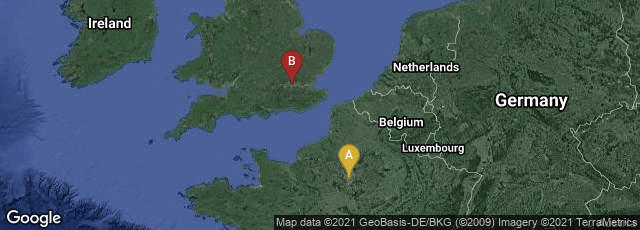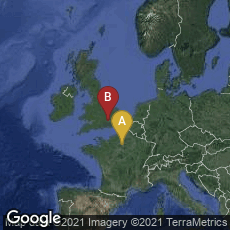

A: Paris, Île-de-France, France, B: London, England, United Kingdom
In his first historical book, an unillustrated work entitled Notice historique sur l'imprimerie (Paris: Imprimerie Paul Dupont, 1849) printer, historian of printing, and politician Paul Dupont described the many technical innovations in printing and book production that had occurred in the first half of the 19th century. Dupont wrote in a pleasant and positive style, as a booster for the industry, and to promote his own business. Among the topics he covered were the conditions of workers in printing plants. In that chapter he ignored issues such as lead colic from absorbing lead through the skin experienced by typesetters who did not wash their hands often enough. However, he was right in pointing out that working conditions in printing plants were relatively good compared to the scandalous working conditions prevalent in so many industries at the time. This was especially true in Dupont's company specifically, since Dupont was a pioneer in creating savings and investment institutions for his staff, and in developing profit-sharing plans.
With respect to innovation, Dupont recounted as appendix 1 on pp. 153-174 his visit to the William Clowes printing plant in London as early as 1839. Clowes was then the world leader in the application of printing machinery to book production, and Dupont was undoubtedly inspired to employ some of Clowes' innovations as he developed his own very large French printing business.
Dupont built upon his 1849 book to write his far more ambitious 2-volume Histoire de l'Imprimerie published in 1854. That history stands out as the first serious history of printing written by an industrial printer in the 19th century, and it remains a classic interpretation of the history of printing from the perspective of one of the pioneers of the industrialization of the printing industry. It is also useful for its many details particularly of French printing developments in the first half of the 19th century, and, drawing on Dupont's political experience, of legal developments concerning printing and of the impact of printing upon society.
In the three part Appendix to this history Dupont published two very useful timelines:
1. Législation: Analyse des principaux actes législatifs et réglementaires qui ont régli la presse depuis l'introduction de l'imprimerie en France jusqu'a l'époque actuelle.
3.Tableau chronologique des principaux faites qui se rattachent a l'histoire de l'imprimer depuis son origine jusqu'a nos jours.
Dupont's second apprendix was a bibliography of sources that he used listed in chronological order. Strangely, all the non-French titles were translated into French.